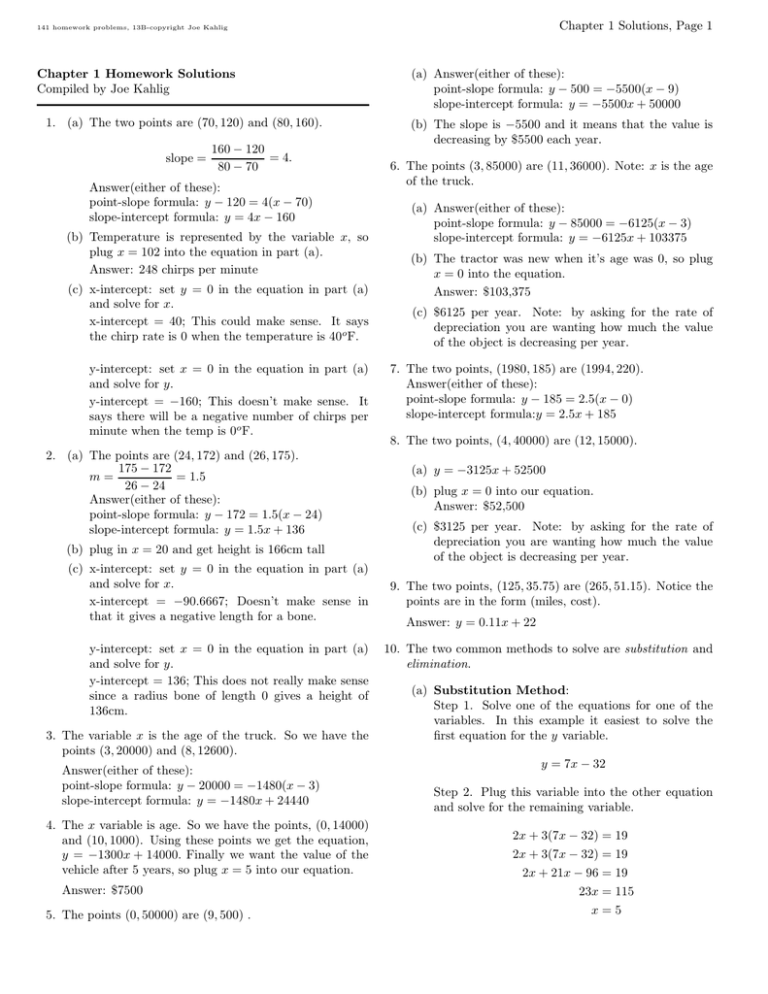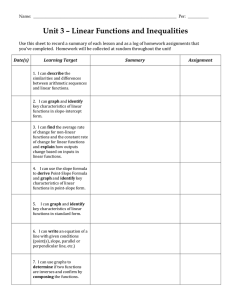Chapter 1 Solutions, Page 1 (a) Answer(either of these):
advertisement

Chapter 1 Solutions, Page 1 141 homework problems, 13B-copyright Joe Kahlig Chapter 1 Homework Solutions Compiled by Joe Kahlig 1. (a) The two points are (70, 120) and (80, 160). slope = 160 − 120 = 4. 80 − 70 Answer(either of these): point-slope formula: y − 120 = 4(x − 70) slope-intercept formula: y = 4x − 160 (b) Temperature is represented by the variable x, so plug x = 102 into the equation in part (a). Answer: 248 chirps per minute (c) x-intercept: set y = 0 in the equation in part (a) and solve for x. x-intercept = 40; This could make sense. It says the chirp rate is 0 when the temperature is 40o F. y-intercept: set x = 0 in the equation in part (a) and solve for y. y-intercept = −160; This doesn’t make sense. It says there will be a negative number of chirps per minute when the temp is 0o F. 2. (a) The points are (24, 172) and (26, 175). 175 − 172 m= = 1.5 26 − 24 Answer(either of these): point-slope formula: y − 172 = 1.5(x − 24) slope-intercept formula: y = 1.5x + 136 (b) plug in x = 20 and get height is 166cm tall (c) x-intercept: set y = 0 in the equation in part (a) and solve for x. x-intercept = −90.6667; Doesn’t make sense in that it gives a negative length for a bone. y-intercept: set x = 0 in the equation in part (a) and solve for y. y-intercept = 136; This does not really make sense since a radius bone of length 0 gives a height of 136cm. 3. The variable x is the age of the truck. So we have the points (3, 20000) and (8, 12600). Answer(either of these): point-slope formula: y − 20000 = −1480(x − 3) slope-intercept formula: y = −1480x + 24440 4. The x variable is age. So we have the points, (0, 14000) and (10, 1000). Using these points we get the equation, y = −1300x + 14000. Finally we want the value of the vehicle after 5 years, so plug x = 5 into our equation. Answer: $7500 5. The points (0, 50000) are (9, 500) . (a) Answer(either of these): point-slope formula: y − 500 = −5500(x − 9) slope-intercept formula: y = −5500x + 50000 (b) The slope is −5500 and it means that the value is decreasing by $5500 each year. 6. The points (3, 85000) are (11, 36000). Note: x is the age of the truck. (a) Answer(either of these): point-slope formula: y − 85000 = −6125(x − 3) slope-intercept formula: y = −6125x + 103375 (b) The tractor was new when it’s age was 0, so plug x = 0 into the equation. Answer: $103,375 (c) $6125 per year. Note: by asking for the rate of depreciation you are wanting how much the value of the object is decreasing per year. 7. The two points, (1980, 185) are (1994, 220). Answer(either of these): point-slope formula: y − 185 = 2.5(x − 0) slope-intercept formula:y = 2.5x + 185 8. The two points, (4, 40000) are (12, 15000). (a) y = −3125x + 52500 (b) plug x = 0 into our equation. Answer: $52,500 (c) $3125 per year. Note: by asking for the rate of depreciation you are wanting how much the value of the object is decreasing per year. 9. The two points, (125, 35.75) are (265, 51.15). Notice the points are in the form (miles, cost). Answer: y = 0.11x + 22 10. The two common methods to solve are substitution and elimination. (a) Substitution Method: Step 1. Solve one of the equations for one of the variables. In this example it easiest to solve the first equation for the y variable. y = 7x − 32 Step 2. Plug this variable into the other equation and solve for the remaining variable. 2x + 3(7x − 32) = 19 2x + 3(7x − 32) = 19 2x + 21x − 96 = 19 23x = 115 x=5 Chapter 1 Solutions, Page 2 141 homework problems, 13B-copyright Joe Kahlig Step 3. Plug this answer into the original equation from step 1. y = 7(5) − 32 = 3. Answer: x = 5, y = 3 (b) Elimination Method: Step 1. Multiply each equation by a number so that the coefficient in front of the variable x (or possible y) are the same except for their sign. For this problem multiply the top equation by −2 and the bottom equation by 3. (c) P = R − C = 0.25x − (.15x + 650) = 0.1x − 650 13. The cost function is C = vc ∗ x + f c where vc is the variable cost, i.e. cost per item, and fc is the fixed cost. From the problem we know that vc = 5 and that when x = 20 then C = 500. Use this to solve for the fixed cost. 500 = 5 ∗ 20 + f c 400 = f c Thus C = 5x + 400. 6x + 15y = 21 From the problem we know that when x = 30 then the profit is 290. Also, Profit=Revenu-Cost and the revenue function is R = A ∗ x where A is the price that each item is sold. Step 2. Add the equations together and then solve for the remaining variable. P = A ∗ x − (5x + 400) 290 = A ∗ 30 − (5 ∗ 30 + 400) −6x + 8y = −44 23y = −23 y = −1 Step 3: Plug in the value of the variable into any of the equations. 3x − 4(−1) = 22 3x + 4 = 22 3x = 18 x=6 Answer: x = 6, y = −1 (c) No solution. If you ever get something that doesn’t make sense (like 1 = 0 or something) then there is no solution. (d) x = (e) x = 18 −17 11 , y = 11 9 −10 7, y = 7 11. Break even means that cost and revenue are the same, so we need to solve C = R. 15x + 12000 = 21x. Once we’ve found x, plug this into either equation (or both to check our answer) to find the rest of the point. Answer: (2000, 42000) 12. (a) R = 0.25x since each scantron is sold for $0.25. (b) The cost function is C = vc ∗ x + f c where vc is the variable cost, i.e. cost per item, and fc is the fixed cost. From the problem we know vc = 0.15. We also know that when 6500 units are sold the store breaks even, so when x = 6500 we have Cost = Revenue, so we have to solve 0.25(6500) = 0.15(6500) + f c f c = 650. Answer: C = 0.15x + 650 290 = 30A − 550 840 = 30A A = 28 Thus R = 28x 14. (a) The cost function is C = 0.75x + 45 here x is the number of questions he answers. Revenue is R = Ax where A is the selling price per item. Also, Profit = Revenue - Cost. From the problem we know that when x = 40 then P = 15. So we need to solve the following: 15 = A ∗ 40 − (.75 ∗ 40 + 45) 15 = 40A − 75 90 = 40A A = 2.25 Answer: $2.25 (b) Break even is when Revenue = Cost, so we must solve 2.25x = .75x + 45 Answer: 30 questions. 15. general formulas are R=A*x and C = vc*x + fc A = selling price per item vc = cost per item fc = fixed cost of the business The problem tells us that fc = 600 (monthly rent). When x = 60 then the cost is 1680 so solve for the variable cost. 1680 = vc · 60 + 600 vc = 18 Revenue = Cost when 40 cds are sold. A · 40 = 18 · 40 + 600 A = 33 141 homework problems, 13B-copyright Joe Kahlig Answers:R = 33x C = 18x + 600 P = 15x − 600 16. (a) P = R − C = 500x − (240x + 2405) = 260x − 2405 (b) When your solve for x when P = 0 or R = C, you get x = 9.25. This is thousand of cups sold. Multiply by 1000 to get the number of cups sold. Answer: 9250 cups of lemonade. (c) Plug in x = 9.25 into the revenue function. Answer: $4625. 17. Use the points (10, 159) and (40, 99). Remember that the points are of the form (x,p) where x = quantity and p = price. Answer: p − 159 = −2(x − 10) or simplified to p = −2x + 179 18. (a) The two points are (700, 580) and (1300, 940). The points are taken from the supply information. Answer: p = 0.6x + 160 (b) The two point are (2000, 400) and (1500, 500). The points are taken from the demand information. Answer: p = −0.2x + 800 (c) Since both equations (in part a and b) are set equal to p, then you can set the equations and solve for x. Answer: (800, 640) 19. Use a method shown in problem 10 to solve the system of equations. Note: The chapter 2 material will make solving this type of problem easier. Equilibrium quantity is 6580 items. Equilibrium price is $424. 20. (a) Note: The problem specifies that the value of x is the number of rackets and p is price in dollars. The two points are (8000, 120) and (3000, 230). Answer: p = −0.022x + 296 (b) Solve the supply and demand equations simultaneously using a method outlined in problem 10. This answer will be the x value. Answer: 4400 rackets (c) The p value from part (b). Answer: $199.20 21. (a) x is in thousands of units so our points are (3, 31) and (8, 16). Answer: 3x + p = 40 (b) Solve the supply and demand equations simultaneously using a method outlined in problem 10. The answer will be 1000 times the x value. Answer: 6000 markers (c) The p value from part (b). Answer: $22 Chapter 1 Solutions, Page 3 22. (a) The two points are (0, 1.5) and (600, 3). Answer: p = .0025x + 1.5 (b) Solve the supply and demand equations simultaneously using a method outlined in problem 10. This answer will be the x value. Answer: x = 200








